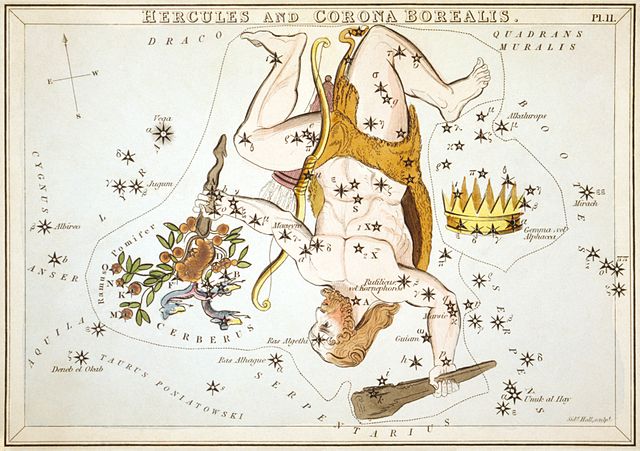Corona Borealis is a small constellation in the Northern Celestial Hemisphere. It is one of the 48 constellations listed by the 2nd-century astronomer Ptolemy, and remains one of the 88 modern constellations. Its brightest stars form a semicircular arc. Its Latin name, inspired by its shape, means "northern crown". In classical mythology Corona Borealis generally represented the crown given by the god Dionysus to the Cretan princess Ariadne and set by her in the heavens. Other cultures likened the pattern to a circle of elders, an eagle's nest, a bear's den or a smokehole. Ptolemy also listed a southern counterpart, Corona Australis, with a similar pattern.
The constellation Corona Borealis as it can be seen by the naked eye
X-ray image of galaxy cluster Abell 2142
Hercules and Corona Borealis, as depicted in Urania's Mirror (c. 1825)
In Greek mythology, Ariadne was a Cretan princess and the daughter of King Minos of Crete. There are different variations of Ariadne's myth, but she is known for helping Theseus escape the Minotaur and being abandoned by him on the island of Naxos. There, Dionysus saw Ariadne sleeping, fell in love with her, and later married her. Many versions of the myth recount Dionysus throwing Ariadne's jeweled crown into the sky to create a constellation, the Corona Borealis.
Ariadne asleep at Hypnos's side. Detail of ancient fresco in Pompeii
Bacchus and Ariadne by Titian: Dionysus discovers Ariadne on the shore of Naxos. The painting also depicts the constellation named after Ariadne.
Bacchus and Ariadne, Guido Reni, c. 1620
The abandoned Ariadne, ancient fresco from Pompeii, National Archaeological Museum, Naples







